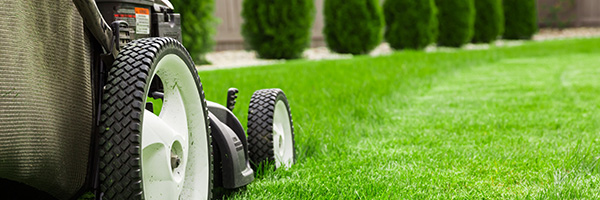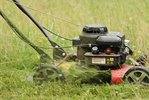Yard Waste

Many homeowners and landscape maintenance companies are guilty of sweeping or blowing yard waste, like grass clippings and fallen tree leaves, in the street or down the storm drain. When it rains, yard waste left in streets, on sidewalks, or in driveways will wash into nearby storm drains. Once in the storm drain system, the yard waste can enter local bodies of water without being treated or cleaned.
The problem
While grass clippings, tree leaves, and other yard waste are natural, they still pollute our local waterways. As yard waste breaks down or decomposes in a local creek, stream, river, or lake, it depletes the oxygen in the water. Aquatic life, such as fish, need oxygen to survive. If oxygen levels become too low, fish and other aquatic life cannot survive.
 If grass clippings and tree leaves are washed or dumped down a storm drain, the storm drain may become clogged. The next time that it rains, or yard irrigation runs off into the street, the water that would normally flow down the storm drain will be blocked by the yard waste. This can cause flooding.
If grass clippings and tree leaves are washed or dumped down a storm drain, the storm drain may become clogged. The next time that it rains, or yard irrigation runs off into the street, the water that would normally flow down the storm drain will be blocked by the yard waste. This can cause flooding.
In some cities, blowing or sweeping yard waste into streets, sidewalks, driveways, or storm drains is illegal. If caught, you could receive a ticket for this violation. Communities are on the lookout now more than ever for polluters, so handle yard waste properly.
How to properly handle yard waste
Leave it on the lawn, use it to improve your landscape, or compost it!
Follow the "Don’t Bag It!" Lawn Care and Leaf Management plans for:
Mowing
 “Leaving it on the lawn” and “Don’t Bag It!” methods aim to recycle your yard waste – and its nutrients – back into your landscape. This may reduce your need for chemical fertilizers. The rule of thumb for mowing the lawn is remove no more than one-third of the grass surface at any one time. With this mowing schedule, you no longer need to bag your grass clippings but can instead leave them on the lawn. (Do not mow when your grass is wet, as wet clippings clump together and smother your lawn.)
“Leaving it on the lawn” and “Don’t Bag It!” methods aim to recycle your yard waste – and its nutrients – back into your landscape. This may reduce your need for chemical fertilizers. The rule of thumb for mowing the lawn is remove no more than one-third of the grass surface at any one time. With this mowing schedule, you no longer need to bag your grass clippings but can instead leave them on the lawn. (Do not mow when your grass is wet, as wet clippings clump together and smother your lawn.)
| Type of Grass | Mower Setting (Inches) | Mow When or Before This Height (Inches) |
| Common Bermuda | 1-1/2 | 2-1/4 |
| "Tif" Bermuda | 1 | 1-1/2 |
| Blue grass | 2 | 3 |
| Buffalo | 2 | 3 |
| Centipede | 2 | 3 |
| St. Augustine | 2 | 3 |
| Tall Fescue | 2-1/2 | 3-3/4 |
| Zoysia | 2 | 3 |
Grass clippings left on the lawn do not contribute to thatch, but return valuable nutrients to the soil. They contain about four percent nitrogen, 0.5 percent phosphorus, and about two percent potassium, as well as the necessary minor elements plants need. During the fall, you may not need to rake your leaves and collect them. Instead, you could mow them! A light covering of leaves can be mowed without the catch-bag attachment, leaving the shredded leaves on the lawn. This technique is most effective when a mulching mower is used. With light leaf drop, this is the easiest and most efficient way to manage leaf accumulation. And as leaves contain 50 to 80 percent of the nutrients that a plant extracts from the soil and air during the growing season, you’re taking advantage of a natural resource.
Mulching
 Mulching is a simple and effective way to recycle leaves and improve your landscape. It reduces evaporation from the soil surface, inhibits weed growth, moderates soil temperatures, keeps soils from eroding and crusting, and prevents soil compaction. As organic mulch decomposes, valuable nutrients are released for use by plants. Leaves can be used as mulch in vegetable gardens, flowerbeds, and around shrubs and trees.
Mulching is a simple and effective way to recycle leaves and improve your landscape. It reduces evaporation from the soil surface, inhibits weed growth, moderates soil temperatures, keeps soils from eroding and crusting, and prevents soil compaction. As organic mulch decomposes, valuable nutrients are released for use by plants. Leaves can be used as mulch in vegetable gardens, flowerbeds, and around shrubs and trees.
As an option to raking, a lawnmower with the catch-bag attachment provides a fast and easy way to shred and collect the leaves. Leaves that have been mowed or run through a shredder will decompose faster and are more likely to remain in place than unshredded leaves.
Soil Improvement
Leaves may be collected and worked directly into garden and flowerbed soils. A six- to eight-inch layer of leaves tilled into a heavy, clay soil will improve aeration and drainage. The same amount tilled into a light, sandy soil will improve water and nutrient holding capacity. In vegetable gardens and annual planting beds, collect and work leaves into the soil during the fall. This allows sufficient time for the leaves to decompose prior to spring planting.
Composting
 What is compost? Compost is a dark, crumbly and earthy-smelling form of organic matter that has gone through a natural decomposition process.
What is compost? Compost is a dark, crumbly and earthy-smelling form of organic matter that has gone through a natural decomposition process.
Compost can be used to:
- enrich the soil by adding nutrients
- loosen tight, heavy soils
- help sandy soils retain moisture and nutrients
- add to potting soils for container grown plants
- mulch around landscape plants and gardens
What makes compost? Bacteria, fungi, beneficial nematodes, mites, springtails, wolf spiders, and other beneficial insects break down organic materials into the rich, soil-like material known as compost. How easily bacteria are able to decompose organic material is determined by the carbon-nitrogen ratio (C:N). All living organisms need relatively large amounts of carbon ("browns") and smaller amounts of nitrogen ("greens"). “Brown” materials include fallen leaves, corn stalks, straw, paper, and sawdust. “Green” materials include vegetable scraps, coffee grounds or grass clippings. A ratio of two-thirds “brown” and one-third “green” is a good rule of thumb to achieve light, fluffy compost.
Do not add diseased or insect-infested plant materials, pet droppings, noxious weeds, meat, dairy products, cooking oil, grease, fat and meat trimmings, or table scraps to your compost pile.
To create compost, small pieces of "greens" and "browns," microorganisms, air, water, volume (3x3x3 feet), and time are needed. A small amount of garden soil or compost can provide sufficient microorganisms, the fungi and bacteria that break down the material. The right amount of air and water provide a favorable environment for the microorganisms to decompose the organic materials and make compost.
Air is the only ingredient that you can’t add too much of to your pile. A lack of nitrogen to "feed" the microorganisms will slow the process, while an excess amount is wasteful and can kill the microorganisms. Too much water limits the amount of air (oxygen) available to the microorganisms, inhibiting their activity. One common method of building a compost pile is in layers. The five steps are:
- Step 1: Place a layer of coarse material such as tree branches on the ground.
- Step 2: Add a six- to eight-inch layer of organic material such as shredded leaves or grass clippings.
- Step 3: Add a one-inch layer of manure or rich garden soil.
- Step 4: Repeat these layers and keep the pile moist.
- Step 5: Stir the pile weekly during the summer and monthly during the winter.
As composting occurs, heat is generated, often causing temperatures to rise to 140°F or higher. It takes about 90-120 days to have ready-to-use compost.
Resources
NCTCOG Stormwater Education Video Playlist on YouTube
U.S. Environmental Protection Agency, “Composting at Home”
Texas A&M AgriLife Extension, Composting
Texas A&M AgriLife Extension, Earth-Kind® Publications
Take Care of Texas, Guide to Yard Care (PDF - English)
North Central Texas Council of Governments (NCTCOG) - Yard Waste Brochure for Homeowners (English/Spanish) and for Landscape Maintenance Companies (English/Spanish)
City of Dallas - Yard Waste Brochure (English/Spanish)
